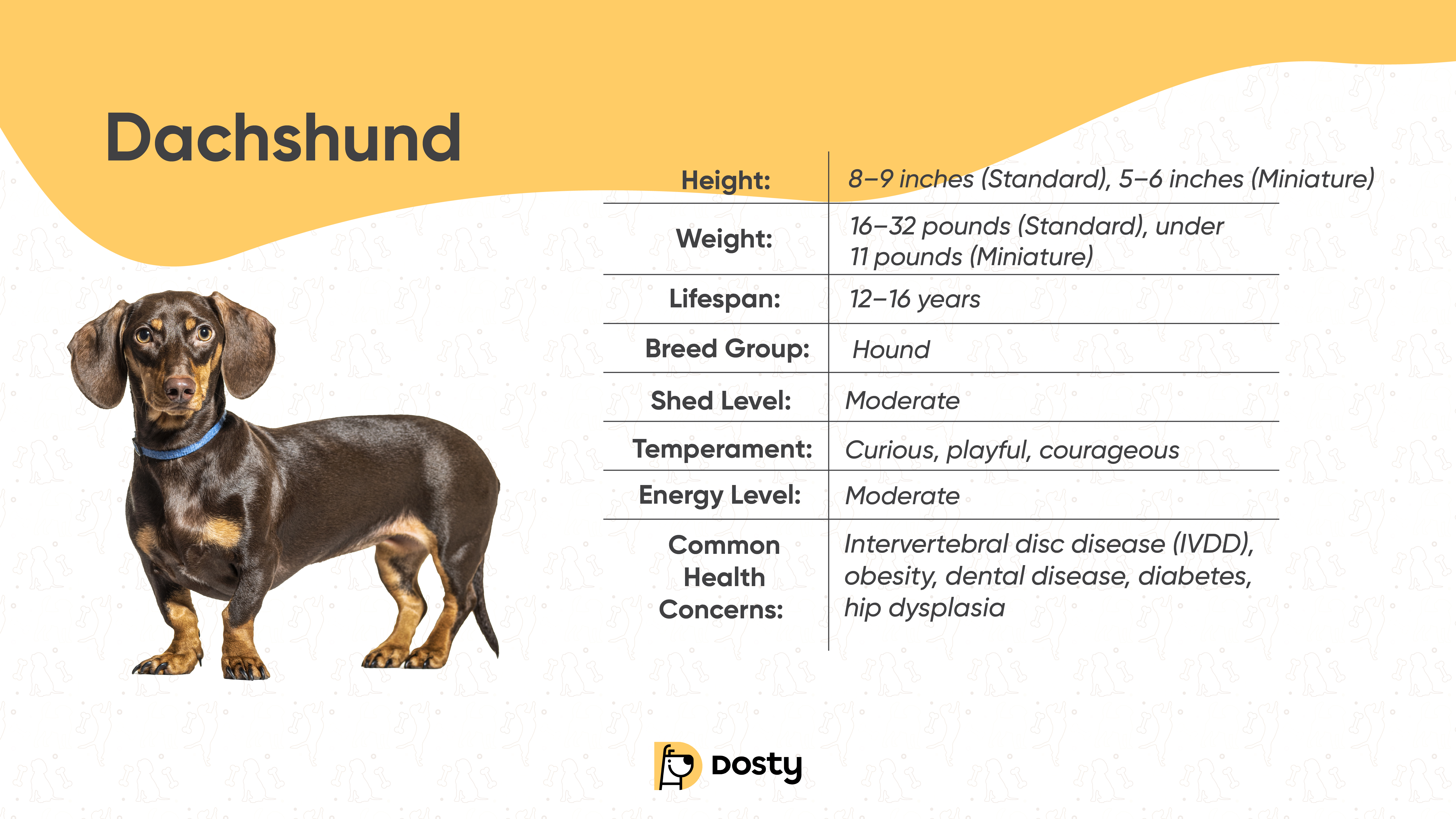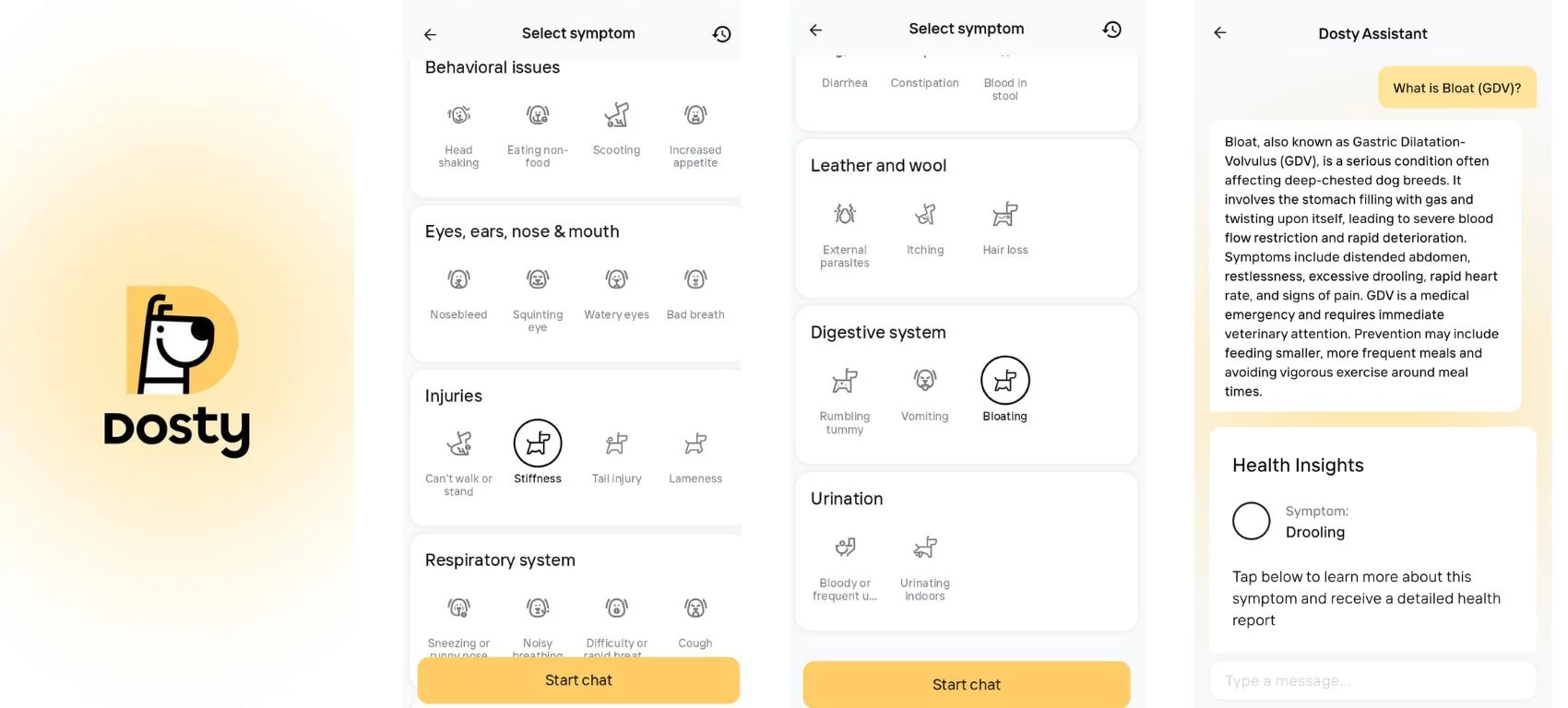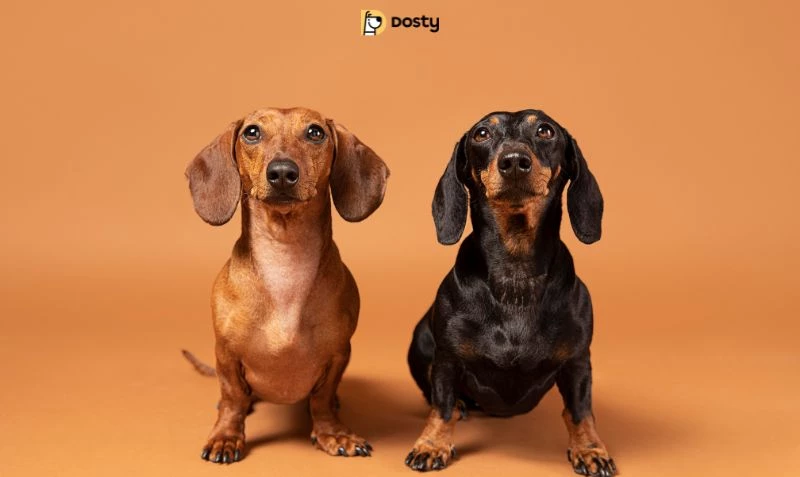On this page
About the Dachshund
The Dachshund, sometimes known as the “wiener dog”, is a fearless hunting breed that comes in a small package. Developed in Germany in the 1600s, these dogs were bred using Basset Hounds and Pinschers to create a long-bodied, short-legged breed with the stamina necessary to hunt badgers, foxes and rabbits. The name Dachshund means “badger dog” in German.
There are three Dachshund coat types - smooth, long-haired, and wired-haired and each has different grooming needs. They also come in a miniature and a standard size and can accommodate different-sized living spaces. They may be small, but Dachshunds have the big personalities to back it up — they have the reputation of being brave, clever, and exceptionally faithful.
💡 Quick Facts About Dachshunds

“Dachshunds are lively, intelligent, and affectionate,” Dr. Manal Rakrak said. But their long spine means they can are prone to back problems so they need careful handling, and need to watch their weight.”
👉 Dachshunds are small, but they have a lot of care needs! Discover how to keep them happy, healthy, and pumped up.
What Makes Dachshunds Different from Other Breeds?
Dachshunds are one of the most unique-looking dog breeds, but it isn't just their looks — their personality and hunting instincts make them stand apart too.
What Makes Dachshunds Special?
Long body and short legs – Built to dig and run after prey underground.
Fearless and determined – They are, arogant and independent hunters despite their size.
Baritone bark – They have a deceptively strong bark for a small dog.
Intelligent – Stubborn – Train with patience and consistency.
_1742287062.jpg)
Does Coat Color Influence Dachshunds’ Temperament?
Dachshund coat colors include red, black and tan, chocolate, cream and dapple. Coat color does not influence temperament directly, but some owners and breeders believe certain coat variations have slight personality differences.
- Dapple & Piebald Dachshunds – There are some claims this pattern is more sensitive or nervous but there is no scientific proof of this.
- Solid-Colored Dachshunds – They are usually said to enjoy a more even-tempered and stable personality.
- Wirehaired Dachshunds — Not a color variation, but a coat type. Thanks to their terrier roots, they can be higher energy and sassier.
“Dachshunds were engineered to be independent problem-solvers so they’re intelligent, but sometimes headstrong, when it comes to training,” says Dr Scott Miller.
_1742294880.webp)
How Big Do Dachshunds Get?
Dachshunds come in two main sizes, each with different weight and height ranges.
Dachshund Growth Chart
_1742301236.jpg)
Dachshunds are full height by 12 months but are still developing muscle at 18 months.
Miniature Dachshunds are better for apartment spaces, but Standard Dachshunds may need a little more room to run around.
Track Your Dachshund’s Growth & Health with Dosty❗
Miniature and Standard Dachshunds both need to be kept at an appropriate weight in order to avoid spinal problems, including IVDD. Monitor your Doxie’s growth with the Dosty App, set weight goals and receive health expert tips to keep your Doxie happy and active!
📲 Begin your tracking today, because every inch, and pound, counts!
Are Dachshunds Good Family Dogs?
Yes, Dachshunds can be loyal, loving and full of character companions for some families. This is why they love human company, they form a close connection with their owners and enjoy being a part of everyday life.
The reason why dachshunds make great family pets:
✅ Lovey-Doveys – These mini-hounds are extremely loyal, and tend to be "velcro dogs," following their humans everywhere.
✅ Excellent Watchdogs – Even though they're small, Dachshunds have a protective instinct and will alert their family of anything unusual.
✅ Fun & Playful – Their quirky, comical personality makes them engaging and entertaining pets. Their joyful spirit lights up the whole house.
How Dachshunds Get along with Children
Dachshunds can be wonderful with children, if they are socialized from a young age. They like to play and be petted, but have fragile backs and spines due to their long bodies and need to be treated gently. Parents should teach young children the proper way to lift them up, and not play roughly, otherwise they risk being injured.
Snoozing by the Fire: Older children who relate to gentle play will have an affectionate, fun-loving companion in a Dachshund. However, supervision is always advised, particularly with very young children.”
Consider Before Bringing a Dachshund into Your Family
✅ Handling Should be Gentle — Small children have really fragile backs and can get injured easily if released over a high surface.
❌ Independent & Stubborn — They can be intelligent, though they also have a mind and attitude of their own, thus training should be patient and consistent.

📲 Train smarter and enjoy a quieter home❗
How Active Are Dachshunds?
Become new to shelter dogs Dachshunds are small but mighty with high energy levels needing regular walks. Its hunting background makes it a fan of chasing, digging and exploring, which means they’re more active than many toy breeds.
Dachshund Exercise Needs:
- Walk Daily: 30–60 minutes of walking at a minimum per day.
- Interactive Play: Games such as fetch, tug-of-war or scent-tracking help keep them entertained.
- Mental Stimulation: Helps avoid boredom through puzzle toys and obedience training.
Avoid High-Impact Activities:
Dachshunds have long backs and short legs, which puts them at risk for spinal injuries. Avoid:
🚫 Leaping on/off furniture - Use pet ramps to avoid back injury.
🚫 Too much stair climbing - Can lead to serious spinal stress.
🚫 Rough play with larger dogs - A good way to injure their delicate spine.
📢 The Only Way to Keep Your Dachshund Healthy❗
Dachshunds are lively little adventurers, but they have long backs that require special attention. The Dosty App allows you to develop the ideal exercise and training routine that allows you to
keep them in shape, entertained, and away from injury!
✅ Find safe activities for Dachshunds to enjoy
💪Learn how to train them to burn some of that energy off
✅ Discover the expert tips to avoid spinal injuries
🐾 This is how you get started, but first, download the Dosty App.

What Should Dachshunds Eat?
To keep their muscles strong and energy levels high, Dachshunds need a high-protein, well-balanced diet. The long body and short legs put additional stress on their spine, making proper nutrition key in controlling their weight and supporting joint health.
Best Diet for a Dachshund:
✔ Protein (30-40%) – Helps muscle strength (chicken, turkey, fish, beef)
✔ Healthy Fats (15-20%) – Supports brain function and coat health (salmon oil, flaxseed).
✔ Complex Carbohydrates (20-30%) – Provides steady energy (sweet potatoes, brown rice)
✔ Joint Supplements – Prevents IVDD and arthritis (glucosamine, chondroitin)
“Dachshunds are at risk of weight gain as weight can increase their risk of intervertebral disc disease (IVDD),” says Dr. Rachel Siu. “Developing a healthy spine and joints requires a high-fiber diet but protein must also be controlled.”
Foods to Avoid:
❌ Fatty or greasy foods — Cause pancreatitis and obesity.
❌ Raisins, chocolate, onions, and garlic – Poisonous to dogs and can lead to serious health problems.
❌ Too many treats – Should be at most 10 percent of daily calories.
All you need to know about keeping your Dachshund healthy begins with what food you feed them❗
Dachshunds love food, but an inappropriate diet can make them weigh too much, causing back problems. The Dosty App provides customized nutrients for your pup to help them stay fit and energetic!
🍗 Discover good protein sources to help support your muscle
🥦 Keeping track of meals and portion sizes to prevent overeating
🚫 Find out which food your pup can eat and which to stay away from
_1742296423.webp)
How Much Grooming Do Dachshunds Need?
Dachshunds are low-maintenance dogs, but their grooming requirements differ by coat type. Regular brushing helps maintain their coat healthy, reduces shedding and prevents skin problems.
How to Groom your Dachshund based on Hair Types:
Smooth-Coated Dachshunds:
- Need to be brushed weekly with a soft-bristle brush or grooming mitt to remove loose hair.
- Bathing every 6–8 weeks is plenty unless they get particularly dirty.
- Their thin fur leaves them susceptible to cold, so they might need a sweater in case of winter.
Long-Haired Dachshunds:
- Needs to be brushed 3–4 times a week to prevent mats and tangles.
- For their silky coat, use a pin brush or slicker brush.
- Most owners bathe their Basenjis every 4–6 weeks, which helps keep the coat clean without stripping it of natural oils.
Wire-Haired Dachshunds:
- Their harsh coat should be hand-stripped approximately every 6 months to preserve the texture.
- Get rid of fluff if you brush at least twice a week.
- They will require occasional trimming around the face and paws.
Dachshund Unique Grooming Requirements:
✔ Nail Trimming: Every 3–4 weeks; to avoid cracking and discomfort.
✔ Ear Cleaning: Weekly checks to clear up the wax buildup and infections.
✔ Brushing: Brush your hamster’s teeth 2–3x a week to prevent gum disease!
Now It’s Even Easier to Stay on Top of Your Dachshund’s Grooming❗
Dachshunds are low-maintenance pets, but like any dog, they require regular care for their coats, nails and ears. If you’ve ever battled brushing through tangles, trimming nails or simply remembering ear cleanings—you’re not alone!
With the Dosty App, you get:
🖌 No-nonsense grooming tutorials for all coat types
✂️ Pain-free pedicures and buttery ear-cleaning
🛁 Bathing schedules to make sure their skin stays healthy.
🐾 Keep your Doxie looking great with Dosty — no more grooming guesswork!

What Health Issues Are Common in Dachshunds?
The long back and short legs of dachshunds make them susceptible to certain genetic and structural health problems.
Common Health Issues in Dachshunds
❤️ Keep Your Dachshund Happy & Healthy with Dosty❗
Dachshunds Are Small Dogs with Big Health Needs Be it back issues or weight concerns, it all depends on the early care! The Dosty App also helps you manage symptoms, reminds you when it’s time for a vet check-up, and provides expert advice so your pup feels their best.
📲 Your Doxie deserves the best, start using Dosty now.

FAQs About Dachshunds
1. Are Dachshunds aggressive?
Not typically, but bad training can produce stubbornness.
2. Do Dachshunds shed a lot?
Hair loss is determined by the type of coat Smooth coats shed moderately; long-haired shed most; wire-haired shed the least.
3. Are Dachshunds easy to train?
They are both smart, and hard-headed, so training should be consistent and follow the reward system.
4. Do Dachshunds bark a lot?
Yes, they have a deep, loud bark for their size. Training prevents unnecessary barking.
5. How long do Dachshunds live?
Their lifespan is 12–16 years, with some attaining 18 years with care.
Conclusion: Why the Dachshund is a Great Choice
The Dachshund is small but this breed has a mighty spirit, a unique body, playful personality, and loyal nature. A strong hunter with a bold and affectionate disposition, this breed can be an ideal companion for an owner that matches the breed's temperament.
Why Choose a Dachshund?
- Devoted and loving partner.
- Good for apartments or houses.
- Grooming needs that are low-maintenance.
For all the training, back care and weight control they require, they repay their owners with years of love, entertainment and devotion. Whether you choose the miniature or standard size, Dachshunds make household happiness, companionship, and a touch of attitude electric.
👉 Dachshunds are loyal, playful, and full of personality - care for them right, and they’ll be your best friend for life!


_1742295939.jpg)